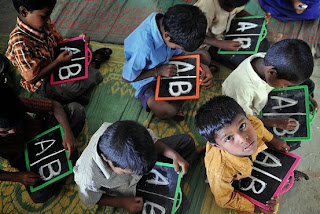"The process of learning does not require only hearing and applying, but also forgetting and remembering again"
Dear bloggers,
I am here again. This post will be the continuation of the previous one. I will also post about the stages of child language acquisition. I also want to see your comments and your recommendations about this theme.
Stages of child language acquisition
From
approximately 2 years of age, children begin to string two content words
together to indicate location, i.e.`daddy gone`, possession `doggie mine` or
action `mommy juice`. Multi-word sentences begin somewhere between ages 2 and
3.At this point they understand word order and context.Through practice they
begin to master the morphology of language and start adding affixes, like
`ing`, so `mommy walk` becomes `mommy walking`.
Learning Language
Children do not learn language simply through
imitation and practice.Children`s early speech seems best explained in terms of
a developing system.Second language learners pass through sequences of
development.Many of these sequences are similar to those of children learning
their first language.
Children`s earliest language is often called `telegraphic`.At this
early age, children leave out many of the small words, like prepositions and
articles.A child`s knowledge of the grammatical system is built up in
predictable sequnces.Grammatical markers such as –ing of the present progressive
or the –ed of the past tense are not acquired at the same time, but in
sequence.The acquisition of certain grammatical features follows similar
patterns in children in different environments.
Child language is not viewed as an incorrect version of
the adult system, but as a system in its own right.Not all errors made by
second language learners could be explained in terms of first language transfer
alone.
Second language learners` errors could be explained better in terms of learners` attempts to discover the structure of the language being learned rather than an attempt to transfer patterns of their first language.Many error types are common to both learners.Both make errors of subject-verb agreement(for example, `a cowboy go` and `three robbers in mountain sees` by learner 1 and `Santa Clause ride` and `they plays` by learner 2). Such errors are clearly not due to first language interference but rather are `developmental` in nature.These are referred to as development errors which might very well be made by children acquiring English as their first language.
Second language learners` errors could be explained better in terms of learners` attempts to discover the structure of the language being learned rather than an attempt to transfer patterns of their first language.Many error types are common to both learners.Both make errors of subject-verb agreement(for example, `a cowboy go` and `three robbers in mountain sees` by learner 1 and `Santa Clause ride` and `they plays` by learner 2). Such errors are clearly not due to first language interference but rather are `developmental` in nature.These are referred to as development errors which might very well be made by children acquiring English as their first language.
Development sequences
 Research on language acquisition has revealed
that there are important similarities between first language learners and
second language learners.In both first and second language acquisition, there
are sequences or `stages` in the development of particular
structures.Developmental sequences are similar across learners from different
backgrounds: what is learned early by one is learned early by others.Children`s
language learning is partly tied to their cognitive development, that is, to
their learning about relationships among people, events or objects around
them. But among second language learners it is more remarkable that
developmental sequences are so similar.Virtually every English sentence has
one or more articles (`a` or `the`), but many learners have great difficulty
using these forms correctly.Natural second language learners acquire grammatical morphemes in much
the same way that first language learners do.
Research on language acquisition has revealed
that there are important similarities between first language learners and
second language learners.In both first and second language acquisition, there
are sequences or `stages` in the development of particular
structures.Developmental sequences are similar across learners from different
backgrounds: what is learned early by one is learned early by others.Children`s
language learning is partly tied to their cognitive development, that is, to
their learning about relationships among people, events or objects around
them. But among second language learners it is more remarkable that
developmental sequences are so similar.Virtually every English sentence has
one or more articles (`a` or `the`), but many learners have great difficulty
using these forms correctly.Natural second language learners acquire grammatical morphemes in much
the same way that first language learners do.
Although a review of all the `morpheme
acquisition` studies that the learner`s first language has a more important
influence on acquisition orders than some researchers would claim.Second
language acquisition has revealed that learners pass through stages of
acquisition which are very similar to those of first language learners.Perhaps
more remarkable is the consistency in the acquisition of word order in
questions.This development is not based on learning new meaning, but rather on
learning different linguistic forms.Second language learners learn to form
questions in a sequence of development which is similar in most respects to
first language question development.Learners who receive grammar-based
instruction still pass through the
same development sequences and make the same types of errors as
those who acquire language in natural settings.
I hope that some of you will find this rewarding for your work and studies. See you soon with new posts.
Kind regards,
Rade.


